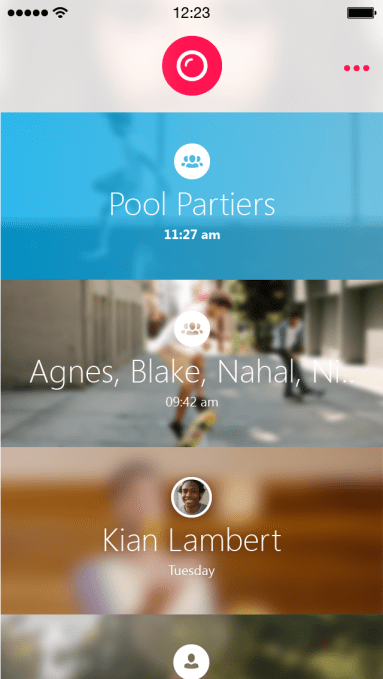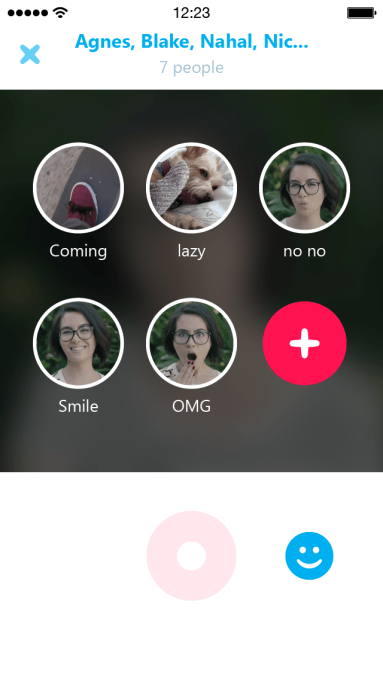If Skype was invented today, what would it look like? This morning, a small team within Skype is attempting to answer that question with the launch of a new video messaging application called Skype Qik, which reimagines how the Skype experience would work if Skype had been built for mobile first.
Instead of focusing on live video calls and instant messaging-like chats, Skype Qik is designed around asynchronous video messaging – that is, mobile video messages you create and share with others who may not be online at the same time as you.
If the name Qik sounds familiar, it’s because that’s the name of the mobile video startup Skype acquired back in 2011. But while some of Qik’s team worked on the new apps for Skype Qik, the technologies are entirely different. Qik was about live video streaming while Skype Qik is closer to a video voicemail experience. And the apps launching today have been built from the ground-up with all new code.
A Skype For The Mobile Era
Explains Dan Chastney, Principal Program Manager Lead at Skype, the new apps still fit into Skype’s larger vision. “Skype for more than a decade now has been about bringing people together when they’re apart, and keeping people connected is still our mission,” he says. “But we’ve seen three major trends that ultimately led us to thinking about doing something new.”
Those include the general shift from desktop to mobile – in fact, more than half of Skype’s new users each month are mobile, Chastney notes, and more people on Skype are connected on mobile than on desktop on a daily basis these days. Plus, there’s been an explosion in options for communication tools, again thanks to mobile. And finally, because of the options we now have available, video calls aren’t scheduled as often as before. Communications are more fluid, and more spontaneous, the company believes.
Skype Qik aims to address the niche underserved by Skype’s flagship application by offering something quicker – so “Qik” turns out to be a good name, it seems.
[gallery ids="1069202,1069201,1069200,1069199,1069198,1069197,1069196,1069195,1069194,1069193,1069192"]
The new app is available now for iOS, Android and Windows Phone simultaneously – impressive since let’s remember that Skype is owned by corporate giant Microsoft, a company that moved so slowly it missed the mobile trend, and arrived too late with a solid Windows Phone offering to achieve significant market share.
Skype Qik, however, operated more like a startup. It has only been in development since Q1 2014, when Skype Qik’s small team got set up in Palo Alto to bang the thing out.
Using Skype Qik
The app itself is simple to use. Users tap the bubbly, pink-ish Skype Qik icon (which resembles that of Skype’s blue icon) and are then presented with a homescreen where all you see is a list of your recent video messages (the blue ones are unread), and a record button.
Recording
This red record button is the only control on the homescreen, and to start recording, you just drag the screen down to open up a camera interface.

From here, you can tap to start recording and tap to stop. You can also switch between the front and back cameras while recording, as you could on any video call today. When recording is complete, you select your recipient or recipients and hit send. For those not on the app, you can optionally send them an SMS that prompts them to download it. (They won’t need to later “friend” you in the app – as soon as they log in, your video is there.)
Responding
Within each group of video messages between two or more Skype Qik users, the video responses are displayed as rounded profile icons at the bottom of the screen, in chronological order.

This aspect of sharing videos back and forth is reminiscent of the many “reaction” messenger apps that were being buzzed about earlier this year. Like Samba, Dubstruck, React Messenger, and others, Skype Qik works well for those who are traveling or stuck in different time zones, where a traditional Skype call doesn’t make sense.
It fills in the gap that was underserved by Skype’s voicemail feature. Voicemails are for when the party doesn’t pick up. Skype Qik is about talking to someone who can’t respond in real-time.
For a bit of fun, you can also pre-record various 5-second video reactions like your “OMG” look or shaking your head “no,” and use these to respond to video messages when you’re not in a position to record a new one. (This feature is live on iOS and Android, and in the works for Windows Phone).

“Ephemeral”
The app also takes note of the trend toward “ephemeral,” or disappearing messages, as videos disappear after two weeks. In addition, only 8 messages display in the app’s carousel – you have to pull on the sides to keep scrolling back in time. You can also delete videos at any time, which deletes them from everyone’s phone. You can block contacts (on Android and Windows Phone; iOS soon). And lastly, new users added to group can only view videos from that point forward.
“We felt we needed a new experience…something that was lightweight,” says Chastney. “But something that would have the intimacy and the richness of video communications which is really what our heritage is, and what Skype is best known for.” Skype Qik may deliver on those larger goals, but it still has to compete in a crowded messaging landscape where dozens of apps are vying for users’ attention.
Skype Qik is available today on iTunes, Google Play and the Windows Phone Store.
